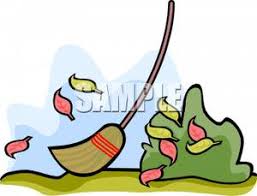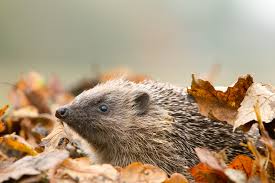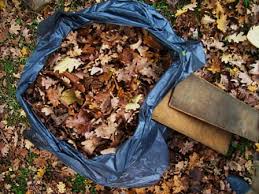Far from a nuisance, fallen autumn leaves should be treasured as a future soil improver. Make the most of this seasonal dividend

Dealing with fallen leaves is synonymous with autumn. Most gardeners who are lucky enough to have deciduous trees will be well versed with in the practice of collecting them, although many may not make the most of this valuable resource.
Leaf litter is a source of free organic matter - and should be used to replenish the garden - either left where they lie, where appropriate, or collected and made into leaf-mould.
If we take our cue from nature and look to deciduous forests, leaf litter there provides a blanket that enriches soil as it breaks down. The eventual result is crumbly dark humus.
 Leave (haha!) or remove?
In a garden, the needs of other plants and fauna must be considered when deciding whether to collect or leave in situ. Fallen leaves will provide a habitat for overwintering animals - such as hedgehogs - but also for slugs; and if leaves are left on lawns they may kill the sward beneath.
Mediterranean plants such as lavenders do not appreciate the humidity leaf litter provides, and it can lead to fungal problems.
When it comes to making leaf-mould, all leaves are not equal. Oak, beech and hornbeam work best. Thicker leaves such as plane and horse chestnut take longer to decay, so shred first. Evergreen laurels and holly do not make good leaf-mould. And lastly, pine needles, though slow to rot, once decayed are an ideal mulch for acid loving-plants.
Leave (haha!) or remove?
In a garden, the needs of other plants and fauna must be considered when deciding whether to collect or leave in situ. Fallen leaves will provide a habitat for overwintering animals - such as hedgehogs - but also for slugs; and if leaves are left on lawns they may kill the sward beneath.
Mediterranean plants such as lavenders do not appreciate the humidity leaf litter provides, and it can lead to fungal problems.
When it comes to making leaf-mould, all leaves are not equal. Oak, beech and hornbeam work best. Thicker leaves such as plane and horse chestnut take longer to decay, so shred first. Evergreen laurels and holly do not make good leaf-mould. And lastly, pine needles, though slow to rot, once decayed are an ideal mulch for acid loving-plants.
Leaves best collected
- Leaves that have fallen onto evergreens such as conifers, evergreen azealeas and silver-leaved plants should be removed promptly before they cause foliage underneath to decay.
- Those that fallin to plants which suffer from winter wet, such as yuccas.
- Those on gravel gardens, paths, drives and drains.
- Those on lawns (and in/on ornamental grasses).
- Ponds and water features will rapidly become clogged if leaves are not removed.
Tools for the job

- Rakes: on a lawn this can be a light plastic or a metal spring-tine rake. Thin spring-tine rakes are great for getting in between plants in beds.
- Leaf blowers now come in various guises, they can even be connected to a solar-powered battery which are lightweight and quieter, in addition to the environmental benefit.
- Use two flat boards held in either hand to scoop up large piles of leaves. Leaf vacuums can be used to suck up piles of leaves.
- On a larger scale, a mower can be used to collect leaves with the added benefit of shredding at the same time, which speeds up the decomposition process.
Using fallen leaves
Once gathered, leaves can be added to the compost heap to counterbalance a mass of green material such as grass-clippings, or kept separate and converted into precious leaf-mould.
Leaf-mould is a great soil improver, either mixed in or as a surface mulch. It will help break down heavy clay; aid sandy soils to retain moisture; and increase worm and micro-organism activity in both situations. The natural place to apply leaf-mould is around trees, shrubs and woodland bulbs. It is also useful in aiding drainage in potting-compost mixes.
Making leaf-mould
 Depending on the scale and space available, the easiest way to make leaf-mould is to collect leaves into a bin bag, loosely tie the top and then pierce holes in the sides. The leaves need to be moist, so add a little water if necessary. These can then be stacked out of the way for 12 - 18 months, in which time the leaves will break down. On a larger scale, a cage can be created using chicken wire and the leaves placed in this. Shredded leaves will break down more quickly, so it can be worth going over piles with a mower first.
Depending on the scale and space available, the easiest way to make leaf-mould is to collect leaves into a bin bag, loosely tie the top and then pierce holes in the sides. The leaves need to be moist, so add a little water if necessary. These can then be stacked out of the way for 12 - 18 months, in which time the leaves will break down. On a larger scale, a cage can be created using chicken wire and the leaves placed in this. Shredded leaves will break down more quickly, so it can be worth going over piles with a mower first.
When to leave in place
An alternative to removing leaves from areas of rougher grass is to use a mower without a collection hood to finely chop up the leaves directly back into the grass. Similarly, in orchards it is fine for fallen leaves to rot down into the grass during winter.
In woodland plantings, shade beds or at the backs of borders, the easiest method is to let any fallen leaves decompose directly onto the bed (after all, we're not looking for work!).
From the that invaluable mine of information, the Royal Horticultural Society (http://www.rhs.org.uk/).
 The Royal Horticultural Society is the UK's leading gardening charity dedicated to advancing horticulture and promoting good gardening. Our goal is to help people share a passion for plants, to encourage excellence in horticulture and inspire all those with an interest in gardening.
The Royal Horticultural Society is the UK's leading gardening charity dedicated to advancing horticulture and promoting good gardening. Our goal is to help people share a passion for plants, to encourage excellence in horticulture and inspire all those with an interest in gardening.
Another use for leaf mould: to 'lighten' for soils such as John Innes No 3, loam-based compost which is recommended for permanently container-grown shrubs, perennials and lilies which, without some sort of organic addition can become rock-like. When two years old or more, leaf mould can be sieved and used, 50/50 with sand, to make fine potting compost for seeds and cuttings.
